Role of hepatic transporters in prevention of bile acid toxicity after partial hepatectomy in mice
- PMID: 19497955
- PMCID: PMC2739828
- DOI: 10.1152/ajpgi.90728.2008
Role of hepatic transporters in prevention of bile acid toxicity after partial hepatectomy in mice
Abstract
The enterohepatic recirculation of bile acids (BAs) is important in several physiological processes. Although there has been considerable research on liver regeneration after two-thirds partial hepatectomy (PHx), little is known about how the liver protects itself against BA toxicity during regeneration. In this study, various BAs in plasma and liver, the composition of micelle-forming bile constituents, as well as gene expression of the main hepatobiliary transporters were quantified in sham-operated and PHx mice 24 and 48 h after surgery. PHx did not influence the hepatic concentrations of taurine-conjugated BAs (T-BA) but increased the concentration of glycine-conjugated (G-BA) and unconjugated BAs. Total BA excretion (microg x min(-1) x g liver wt(-1)) increased 2.4-fold and was accompanied by a 55% increase in bile flow after PHx. The plasma concentrations of T-BAs (402-fold), G-BAs (17-fold), and unconjugated BAs (500-fold) increased. The mRNA and protein levels of the BA uptake transporter Ntcp were unchanged after PHx, whereas the canalicular Bsep protein increased twofold at 48 h. The basolateral efflux transporter Mrp3 was induced at the mRNA (2.6-fold) and protein (3.1-fold) levels after PHx, which may contribute to elevated plasma BA and bilirubin levels. Biliary phospholipid excretion was nearly doubled in PHx mice, most likely owing to increased mRNA expression of the phospholipid transporter, Mdr2. In conclusion, the remnant liver after PHx excretes 2.5-fold more BAs and three times more phospholipids per gram liver than the sham-operated mouse liver. Upregulation of phospholipid transport may be important in protecting the biliary tract from BA toxicity during PHx.
Figures
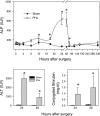
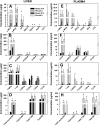
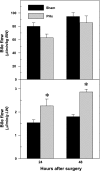
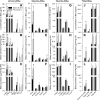

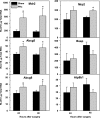

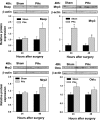
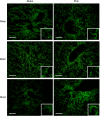

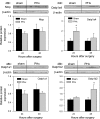

Similar articles
-
Effect of various antibiotics on modulation of intestinal microbiota and bile acid profile in mice.Toxicol Appl Pharmacol. 2014 Jun 1;277(2):138-45. doi: 10.1016/j.taap.2014.03.009. Epub 2014 Mar 20. Toxicol Appl Pharmacol. 2014. PMID: 24657338 Free PMC article.
-
Critical illness evokes elevated circulating bile acids related to altered hepatic transporter and nuclear receptor expression.Hepatology. 2011 Nov;54(5):1741-52. doi: 10.1002/hep.24582. Hepatology. 2011. PMID: 21800341
-
The influences of cholecystectomy on the circadian rhythms of bile acids as well as the enterohepatic transporters and enzymes systems in mice.Chronobiol Int. 2018 May;35(5):673-690. doi: 10.1080/07420528.2018.1426596. Epub 2018 Jan 30. Chronobiol Int. 2018. PMID: 29381405
-
Drug-induced perturbations of the bile acid pool, cholestasis, and hepatotoxicity: mechanistic considerations beyond the direct inhibition of the bile salt export pump.Drug Metab Dispos. 2014 Apr;42(4):566-74. doi: 10.1124/dmd.113.054205. Epub 2013 Oct 10. Drug Metab Dispos. 2014. PMID: 24115749 Review.
-
The role of the sodium-taurocholate cotransporting polypeptide (NTCP) and of the bile salt export pump (BSEP) in physiology and pathophysiology of bile formation.Handb Exp Pharmacol. 2011;(201):205-59. doi: 10.1007/978-3-642-14541-4_5. Handb Exp Pharmacol. 2011. PMID: 21103971 Review.
Cited by
-
Gender-divergent profile of bile acid homeostasis during aging of mice.PLoS One. 2012;7(3):e32551. doi: 10.1371/journal.pone.0032551. Epub 2012 Mar 5. PLoS One. 2012. PMID: 22403674 Free PMC article.
-
Recent Advances in the Digestive, Metabolic and Therapeutic Effects of Farnesoid X Receptor and Fibroblast Growth Factor 19: From Cholesterol to Bile Acid Signaling.Nutrients. 2022 Nov 22;14(23):4950. doi: 10.3390/nu14234950. Nutrients. 2022. PMID: 36500979 Free PMC article. Review.
-
Mechanisms of Triptolide-Induced Hepatotoxicity and Protective Effect of Combined Use of Isoliquiritigenin: Possible Roles of Nrf2 and Hepatic Transporters.Front Pharmacol. 2018 Mar 16;9:226. doi: 10.3389/fphar.2018.00226. eCollection 2018. Front Pharmacol. 2018. PMID: 29615906 Free PMC article.
-
Fibroblast growth factor (Fgf) signaling pathway regulates liver homeostasis in zebrafish.Transgenic Res. 2013 Apr;22(2):301-14. doi: 10.1007/s11248-012-9636-9. Epub 2012 Jul 22. Transgenic Res. 2013. PMID: 22820869
-
A modified animal model of hepatic regeneration induced by hilar bile duct ligation.Sci Rep. 2021 Oct 12;11(1):20201. doi: 10.1038/s41598-021-99758-z. Sci Rep. 2021. PMID: 34642435 Free PMC article.
References
-
- Akita H, Suzuki H, Ito K, Kinoshita S, Sato N, Takikawa H, Sugiyama Y. Characterization of bile acid transport mediated by multidrug resistance associated protein 2 and bile salt export pump. Biochim Biophys Acta 1511: 7–16, 2001. - PubMed
-
- Aleksunes LM, Scheffer GL, Jakowski AB, Pruimboom-Brees IM, Manautou JE. Coordinated expression of multidrug resistance-associated proteins (Mrps) in mouse liver during toxicant-induced injury. Toxicol Sci 89: 370–379, 2006. - PubMed
-
- Andersen B, Zierz S, Jungermann K. Alteration in zonation of succinate dehydrogenase, phosphoenolpyruvate carboxykinase and glucose-6-phosphatase in regenerating rat liver. Histochemistry 80: 97–101, 1984. - PubMed
-
- Balabaud C, Kron KA, Gumucio JJ. The assessment of the bile salt-nondependent fraction of canalicular bile water in the rat. J Lab Clin Med 89: 393–399, 1977. - PubMed
Publication types
MeSH terms
Substances
Grants and funding
LinkOut - more resources
Full Text Sources
Molecular Biology Databases
Miscellaneous

